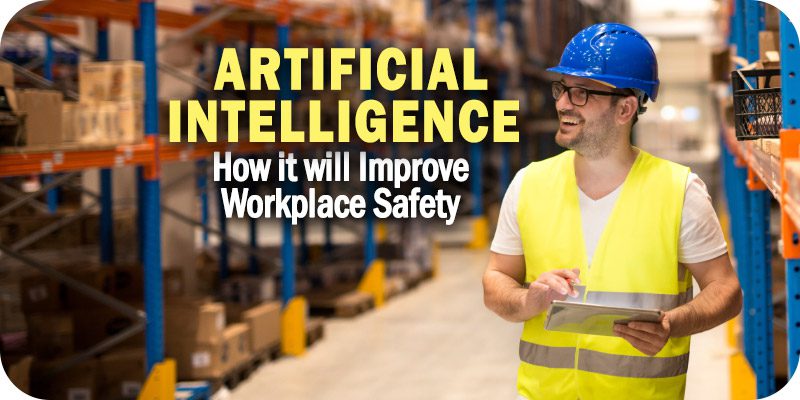How Artificial Intelligence Will Improve Workplace Safety


As part of Solutions Review’s Contributed Content Series—a collection of articles written by industry thought leaders in maturing software categories—Yukon Palmer, the founder and President of FieldLogix, outlines how artificial intelligence (A.I.) technologies can help companies improve their workplace safety.
Artificial intelligence is often viewed as an overly-hyped technology, yet it will eventually impact our everyday lives. Its many applications are used today within many industries to increase revenues and profits. While some perceive A.I. as a threat to jobs, we will begin to see it being used as a tool that can enhance workers’ well-being. In fact, “blue collar” industries such as construction will see the value of harnessing the power of A.I. to improve workplace safety.
A.I.’s most significant benefits revolve around predicting outcomes. To build an A.I. prediction model, you start with the outcome you want to predict and use a machine learning process to analyze all the factors that lead to the result. Often, so many factors, which may even appear to be unrelated, lead to an outcome that even the smartest human cannot accurately predict.
Even very sophisticated computer programs struggle to do this. A.I.’s strength is in digesting millions of factors to predict the likelihood of an outcome, even if many of the factors appear to be unrelated. This process is akin to dumping a bunch of random unprepared meat and vegetables into a pan, putting it in the oven, then pulling out a gourmet casserole after 20 minutes.
Blue-collar industries, in particular, stand to benefit significantly from A.I. technology. It will likely be implemented in areas where these industries feel the most pain, specifically worker safety. According to the National Safety Council, accidents on construction job sites cost organizations $171 billion annually. They are difficult for everyone involved and often result in expensive work stoppages, fines, and lawsuits. Sometimes the factors that lead to the accidents are foreseeable (say, for example, an unsecured ladder).
However, there are many cases where many unforeseeable and non-obvious factors could contribute to an accident. These factors could include a worker’s weak knee from a childhood accident, a slick rung on a ladder due to high humidity, the worker’s weight, the glare of the sun, the fact that the worker isn’t wearing sunglasses, the worker’s lack of sleep from the night before, or a sudden, startling loud noise from a nearby detonation.
There are so many factors that it would be impossible for even the smartest supervisor to notice them and instruct the worker to be more careful during his fifth time climbing the ladder. However, if these factors were input into an A.I. model based on several simple survey questions for the worker, an analysis of the local weather forecast, and the planned activities on the job site, the probability that the worker would fall off of a ladder could be predicted. The supervisor could use this information to instruct the worker to be more careful, reassign the worker to another task, or limit the worker to climbing the ladder four times. All of the worker’s planned tasks for the day could be assessed for risk, and the plans could be modified to reduce the chance that the worker would be involved in an accident.
A.I. could even be used during the job planning phase to assign workers to tasks with a lower risk of accidents based on their circumstances. BHP, a worldwide copper mining company, has put A.I. to use to improve workplace safety in one of their Chilean mines. They implemented “smart caps,” worn on the heads of their mining vehicle drivers, to analyze their brainwave patterns. The brainwave analysis uses A.I. to determine whether the driver is tired and in poor physical condition to operate a vehicle. They then use this data to coach or redirect their drivers to reduce the likelihood that they are involved in accidents.
As organizations realize the potential of A.I., they will put it to use to dramatically reduce accident risk, saving billions of dollars each year. Blue-collar industries will be significant adopters of the technology, not only because of the safety improvements but because they may be pressured to adopt the technology by the ultimate financial losers when there are accident claims, the insurers.
The insurance claims from the 2.6 million annual non-fatal workplace accidents eat into the insurers’ profits, resulting in significant premium increases for their clients. Because of these costs, the insurers will be the biggest proponents of using Artificial Intelligence in the workplace. In many cases, they may underwrite a portion of the cost of the technology or may require that a client purchases it as a prerequisite to being covered by a policy. They already have a history of implementing programs that leverage technology to improve driver safety.
For example, auto insurers have incentivized their clients to utilize telematics solutions for years to monitor their driving habits. For example, auto insurers have incentivized their clients to utilize telematics solutions for years to monitor their driving habits. The Drivewise program by Allstate monitors drivers for unsafe driving practices and rewards safe drivers in the form of lower insurance premiums. Nearly all major auto insurance carriers have similar programs and often subsidize the cost of the technology.
Workplace accidents significantly drain our economy, productivity, and collective well-being. Artificial Intelligence represents an excellent opportunity to solve this problem by predicting and preventing accidents. Not only will the employers see the value of A.I. in improving workplace safety, but the insurance carriers will likely use every method at their disposal to encourage the use of it by employers. This will result in fewer financial losses and healthier workers.























